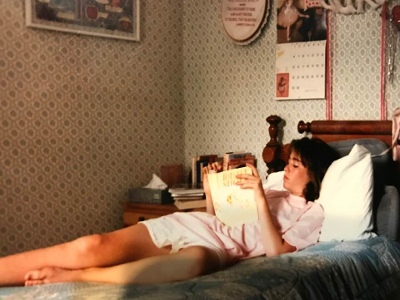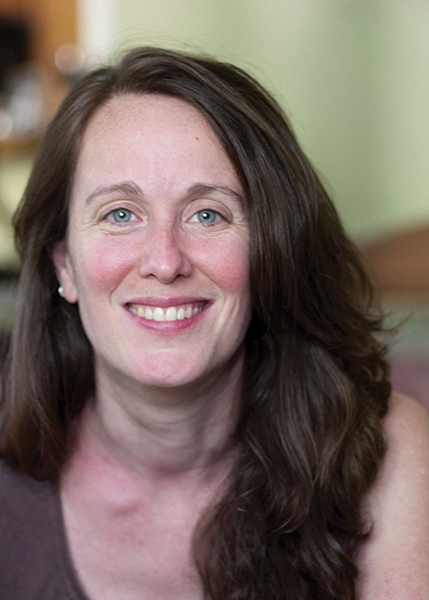The Writer's Page: Not-Quite-All-of-a-Kind: Seeking My Jewish Life in Books
We talk a lot lately about representation in children’s literature, about the need for all kids to see themselves in the books they read. And, of course, this has been a wonderful development, a much-needed change! But personally, I’ve struggled, in thinking back over my own childhood reading, trying to remember the books that were mirrors for me (to use Dr. Rudine Sims Bishop’s term). Identity is necessarily complicated, and as a Jewish kid, I never really saw myself in the Jewish books people slid into my hands.

The author, age eight, in an Easter bonnet, hunting for eggs in her yard.
Photo courtesy of Laurel Snyder.
We talk a lot lately about representation in children’s literature, about the need for all kids to see themselves in the books they read. And, of course, this has been a wonderful development, a much-needed change! But personally, I’ve struggled, in thinking back over my own childhood reading, trying to remember the books that were mirrors for me (to use Dr. Rudine Sims Bishop’s term). Identity is necessarily complicated, and as a Jewish kid, I never really saw myself in the Jewish books people slid into my hands. That isn’t to say that I didn’t enjoy them, only that I read them as a sort of exotica, or as the history of the Jewish people. I read them as research. Because they didn’t resemble my Jewish life very much at all.
My Jewish life was complicated. My mother was Catholic, and though I grew up lighting candles for Shabbat and attending Hebrew school on Sundays, nothing felt easy or automatic. Also, my father was political, a Democratic Socialist who had intentionally moved away from a Jewish suburb of Baltimore and into the city. I attended a school with very few Jewish kids and didn’t have any Jewish friends in the neighborhood either.
 What all this means is that books like Sydney Taylor’s All-of-a-Kind Family, while lovely depictions of traditional Jewish communal life, were actually sort of painful for me to read. In sculpting a narrative of what the tight-knit Jewish community was supposed to be, they served to highlight how very clearly I didn’t belong in that world. So, I read them not as a welcoming hug, but rather as an indication of everything my family was doing wrong. I saw them as a monolith. Of course, I didn’t quite belong in the non-Jewish world either, and so as far as I could tell, I was alone, the only person like me on the planet. The Last Unicorn, maybe. Wandering, in search of my people.
What all this means is that books like Sydney Taylor’s All-of-a-Kind Family, while lovely depictions of traditional Jewish communal life, were actually sort of painful for me to read. In sculpting a narrative of what the tight-knit Jewish community was supposed to be, they served to highlight how very clearly I didn’t belong in that world. So, I read them not as a welcoming hug, but rather as an indication of everything my family was doing wrong. I saw them as a monolith. Of course, I didn’t quite belong in the non-Jewish world either, and so as far as I could tell, I was alone, the only person like me on the planet. The Last Unicorn, maybe. Wandering, in search of my people.
Then I discovered Davita’s Harp by Chaim Potok…
 I don’t remember how I came across it, or why I read it, that first time. I was about twelve, and it was an adult book, technically, but even so, it was about someone my own age — the story of a girl growing up in the 1930s and 1940s — with a Christian father and a Jewish mother, in a family isolated from both religious communities by intermarriage and their Communist politics. But the similarities ran deeper than that. Davita was intensely curious, like me, but often ignorant about her own culture. She was drawn to Judaism but confused about it. She was sometimes shunned by kids from the normative Jewish world. She loved books and had a vivid imagination that blurred the line between reality and her dreams. And, like me, Davita was often very much alone.
I don’t remember how I came across it, or why I read it, that first time. I was about twelve, and it was an adult book, technically, but even so, it was about someone my own age — the story of a girl growing up in the 1930s and 1940s — with a Christian father and a Jewish mother, in a family isolated from both religious communities by intermarriage and their Communist politics. But the similarities ran deeper than that. Davita was intensely curious, like me, but often ignorant about her own culture. She was drawn to Judaism but confused about it. She was sometimes shunned by kids from the normative Jewish world. She loved books and had a vivid imagination that blurred the line between reality and her dreams. And, like me, Davita was often very much alone.
I’m not sure that I can explain fully what Davita meant to me when I found her. Never mind that she was living in Depression-era Brooklyn and entirely fictional. Here, at last, was a Jewish kid like me. There were two of us! And if there were two of us, I figured, maybe there were even more. The leap from alone to not-alone is much greater than the leap from two to many. And so, I read Davita’s Harp over and over, pressed it into my consciousness, a reminder that I would find my people someday. I took Davita’s Harp with me to college and read it yearly. I still have my worn old copy somewhere, and never, from that day to this, have I found a book to rival it for making me feel seen.

Laurel (right) in sixth grade with her next-door neighbor. Photo courtesy of Laurel Snyder.
Then years passed, and by some amazing stroke of luck, I became an actual author, writing books for kids “my age.” (By which I mean that I will forever be about twelve in my own mind.) I have now authored eight books for middle-grade readers, and yet, for some reason, the first seven didn’t really deal with religious identity. Why? I’ve wondered. Why, when given the chance to tell my own story, to provide some other kid “my age” with a Davita-moment, did I not engage? As I published Jewish picture book after Jewish picture book, even winning a Sydney Taylor Book Award, which recognizes titles that “authentically portray the Jewish experience,” I continued to avoid exploring my own Jewish story in middle-grade fiction. I’ve pondered this a lot, and I think that maybe, in picture books, it felt possible for me to keep it simple and focus on one simple moment or element of my own Jewish identity that I thought the majority could share (Jews go camping! Shabbat dinner is fun!). But when I write for middle-grade readers, I work very hard not to skirt the difficult questions or avoid grappling with bewildering emotions. I dig into the complexity, the puzzle.
And when it came to the puzzle of my own Judaism, it just seemed too hard. Not because it’s hard to write books (though it is), but because it’s hard to carve out an identity that you fear other people won’t affirm. It’s hard to claim that space, to say, “Even though people may not recognize my legitimacy, I recognize it.” So many people seem to already have an idea of what a Jewish book is (as well as a Jewish author), and I feared my narrative wasn’t going to match that. It would be a heavy lift, I thought, to disrupt readers’ notions of what it means to be Jewish, offer something beyond their expectations. I was afraid.

Reading Ballet Shoes the summer before seventh grade. Photo courtesy of Laurel Snyder.
But of course, the American Jewish community is diverse and intersectional! Jews are not all white or Ashkenazic. They live all over this country, not just in the Northeast. They are queer and trans, urban and rural, progressive and conservative. The Jewish community encompasses differing approaches to observance, explores creative rituals, and lives in family structures of all kinds. So in actuality, it’s the expectation of a monolithic Jewish experience that is inadequate — not anyone’s actual Jewish identity. Right? And that includes my own.
 Of course, when at last I sat down to tackle the subject in my new novel, The Witch of Woodland, I found it every bit as hard as I’d feared. Offering a truly authentic portrait of my bewildering Jewish experience meant revealing all the ways I do things wrong. Poor Zippy! I demanded that my protagonist own all the perceived inadequacies I’d been covering up my entire life. I forced Zippy to ask all the questions she’s embarrassed by, to stumble through the prayers she doesn’t know how to sing, admit to all the pizza she’s consumed during Passover. I cringed as I wrote The Witch of Woodland.
Of course, when at last I sat down to tackle the subject in my new novel, The Witch of Woodland, I found it every bit as hard as I’d feared. Offering a truly authentic portrait of my bewildering Jewish experience meant revealing all the ways I do things wrong. Poor Zippy! I demanded that my protagonist own all the perceived inadequacies I’d been covering up my entire life. I forced Zippy to ask all the questions she’s embarrassed by, to stumble through the prayers she doesn’t know how to sing, admit to all the pizza she’s consumed during Passover. I cringed as I wrote The Witch of Woodland.
But here is the thing — in the end, that process was exactly what we needed, Zippy and I. Writing The Witch of Woodland, I was able to grant Zippy a grace I’d never allowed myself. I was able to see her journey as authentically Jewish, to appreciate the value of her hard questions, even when she didn’t find easy answers. I was able to love Zippy for the very complexity of her identity and the bravery it took to examine herself and her community. Zippy, like me, dwells awkwardly in the overlapping spaces, the margins of her world, and as I wrote her story, I was able to admire her for how honestly (if not always gracefully or confidently) she navigates them.
And kids need books like this. Books that grant permission to redefine and investigate who they are in all their many messy intersections. Books that represent all communities, but maybe especially the outliers in those communities. Books that admit to not knowing, to not belonging, to feeling inadequate and alone. Because these books have the capacity to prove to an actual child that they aren’t those things at all.
From the November/December 2023 issue of The Horn Book Magazine.

RELATED
ALREADY A SUBSCRIBER? LOG IN
We are currently offering this content for free. Sign up now to activate your personal profile, where you can save articles for future viewing.







Add Comment :-
Comment Policy:
Comment should not be empty !!!
Rachel Fremmer
This is lovely. I'm not sure if Jews are more varied in their observance/affiliation than members of other religions or if we just have more rules to start with, but this kind of Jewish representation is so needed and appreciated.Posted : Dec 18, 2023 08:30